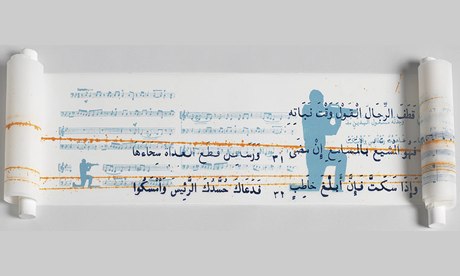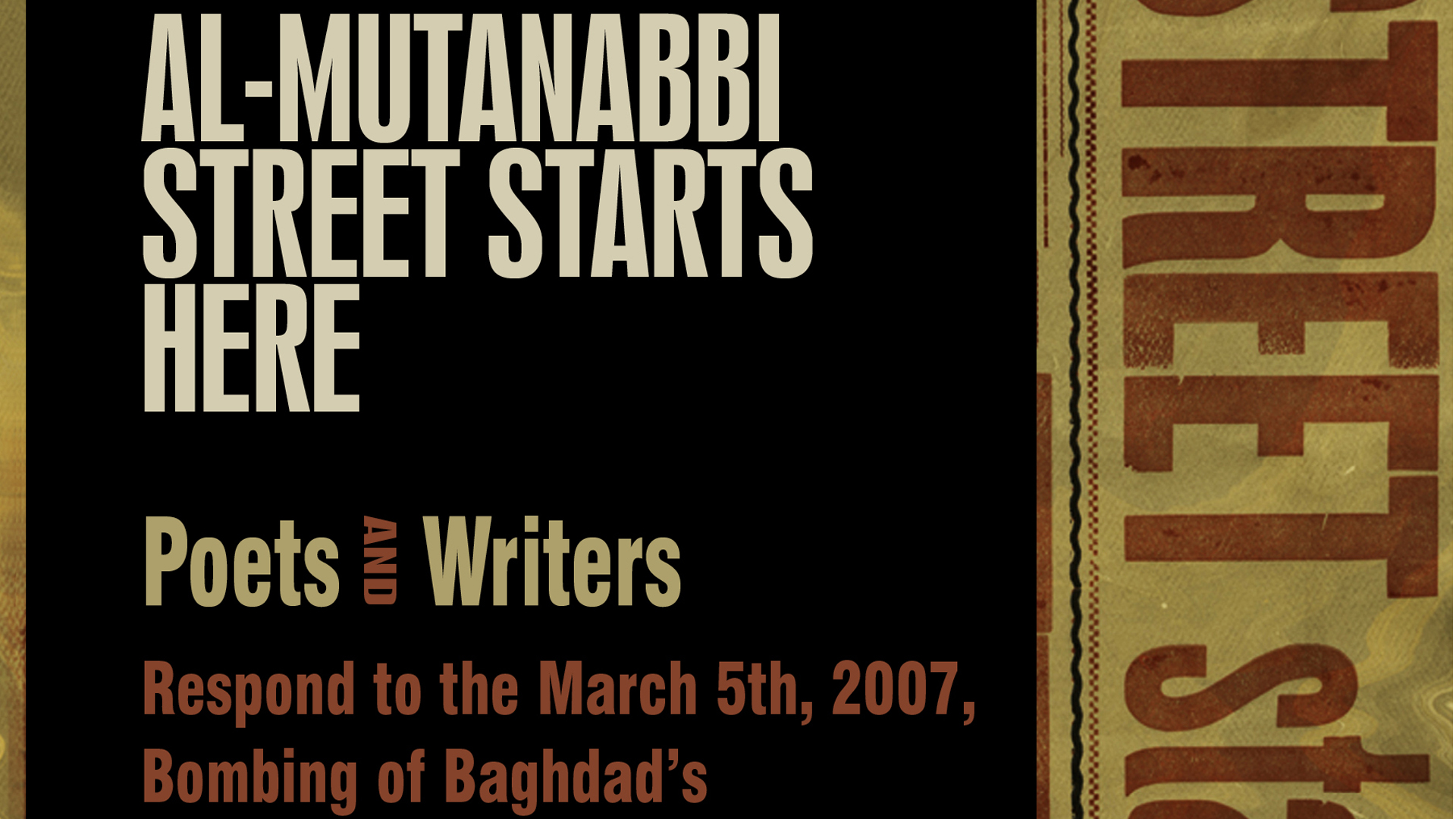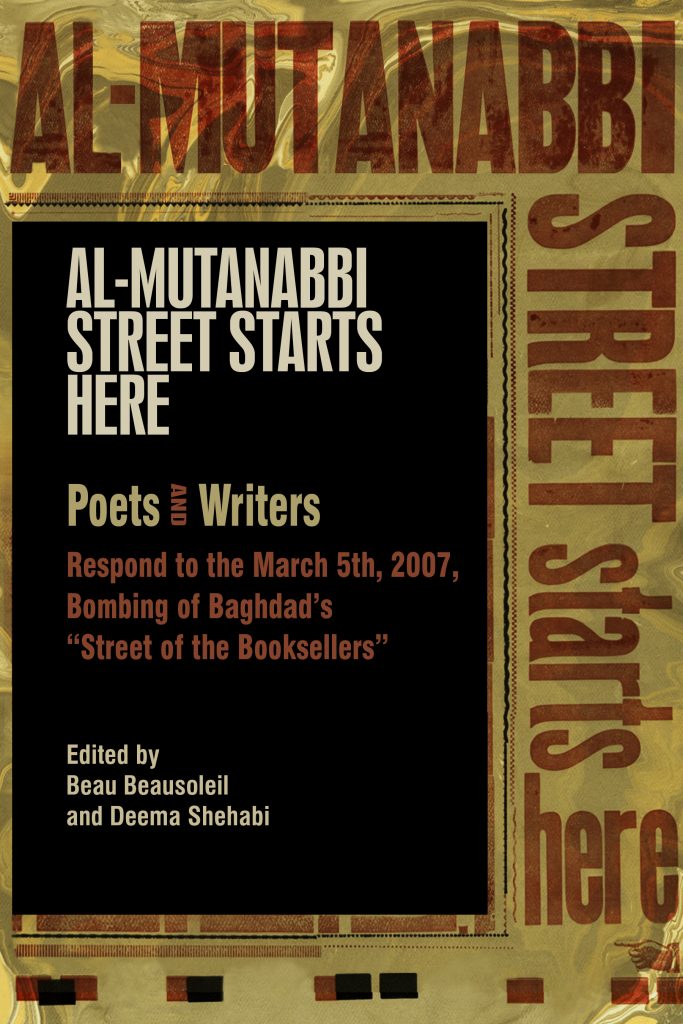by Ellie Violet Bramley
The Guardian UK
January 21st, 2014
Hundreds of writers and artists prepare tributes to Iraq’s historic books hub, Al-Mutanabbi Street, hit by car bomb in 2007
Al-Mutanabbi Street Starts Here – gallery
‘The scroll form made sense’ … Iraqi Peace Song 2011, by Laurie Alpert. The text is by Al-Mutanabbi. Photograph: Mosaic Rooms | Al Mutanabbi Stre

It’s said that when Baghdad was sacked by the Mongols in 1258, the river Tigris ran red one day with the blood of those killed, and black the next with the ink of their books. On 5 March 2007, many of Baghdad’s books once again found themselves the victims of war when a car bomb exploded on Al-Mutanabbi Street, the city’s historic literary district – home of booksellers, printers, and cafes, such as the famous Shabandar cafe, where Iraqi writers and intellectuals have been gathering for centuries.
On reading about the incident in the New York Times the next morning, Beau Beausoleil, a San Francisco-based poet and bookseller, felt an immediate connection: “I knew that if I was an Iraqi that’s exactly where my store would be, among the other bookshops … As a poet that would be my cultural community.” With the bomb, Beausoleil felt that the “tremendous pressure from the government and the media to see people as the other” was punctured; the distance collapsed.
Beausoleil felt compelled to take action to let “people in the west know that we share this commonality with Al-Mutanabbi Street”. In his mind, the response had to be not only vocal but ongoing: “you have to continue to show up and make people think about what is happening and how that relates to their own lives”. So began the Al-Mutanabbi Street project.
It started with a call to letterpress printers to create broadsides – a large sheet of paper printed on one side only, traditionally a poster. Beausoleil felt that letterpress artists were most apt for a first, “tactile, personal response” – “they’re the people who have historically reacted to national tragedy or aspirations for a more just society by putting a broadside up on the side of a building or tree”. A few years on, the project has gathered a collection of broadsides, 133 of which have been digitised by the Florida Atlantic University Libraries to be donated to the National Library and Archive of Iraq. The original target was 130, a number chosen to symbolise the 100 people wounded and the 30 killed that day.
Since then, different shoots to the project have sprung up. There’s an anthology of written responses to the bombing, from Iraqi, American and other international poets and writers. Called Al-Mutanabbi Street Starts Here, it was co-edited by Deema Shehabi, a Palestinian-American poet, and includes contributors ranging from the Pulitzer prize-winning journalist Anthony Shadid, who suffered a fatal asthma attack while covering the Syrian conflict, to Yassin Alsalman, an Iraqi-Canadian journalist and hip-hop MC, AKA The Narcicyst, and Beausoleil himself.
There’s also been a call to book artists (practitioners who realise their works of art in the form of a book, in the tradition of William Blake) to create books that encapsulate both “‘memory and future’, exactly what was lost that day”, in An Inventory of Al-Mutanabbi Street – “both a lament and a commemoration of the singular power of words”. Artists’ books in this inventory use the printers, writers, booksellers and readers of the street as a touchstone and show the “the commonality of Al-Mutanabbi Street with any street, anywhere that holds a bookstore or cultural institution”.
A selection of these artist’s books and the broadsides is currently on display at London’s Mosaic Rooms, and on 22 January there will be a panel event at which two contributing artists, Catherine Cartwright and Mona Kriegler, along with guest speaker Dr Safaa Sangour Al-Salih, will discuss the project’s significance, and the process of responding to and creating artwork for such a venture.
Cartwright is a British artist who got involved with the project as a result of her interest in “human rights issues and how artists can work in a way that promotes, in its widest sense, political or social change”. She sees the project as being about raising awareness and solidarity: “We can get swamped by stories of things that are happening around the world … it’s about showing people who are suffering in Iraq that they’re not forgotten.”
Kriegler, an academic whose expertise is in art and politics in Iraq, felt that in order to “write about art I needed to go through the process of making art”. For her, an important question is how we define solidarity. Her project, she says, “is a project for the Iraqi people about their street, about their pain and suffering, which I haven’t experienced – this is something I find difficult, how do you position yourself?”
In the work she currently has on display at the Mosaic Rooms as part of the Threads of Light/Al-Mutanabbi Street Starts Here exhibition, she looks at the idea of pain and brokenness – “something everyone can relate to, it is not down to a place – pain doesn’t have an identity”. Her work transfers the idea of pain and brokenness on to the human body, and then back on to a map of Baghdad (“a wounded body”) and Al-Mutanabbi Street (“a scar”).
The scar from Baghdad’s explosion is not a one-off: history is punctuated by attacks on the written word and the communities around them. Of course, it is rarely only books that are harmed in such attacks. One video response to the Al-Mutanabbi Street Starts Here project, I Dare You, by artist Stephanie Sauerpart, embeds this Iraqi example in a long list of dates and places when books were burned or otherwise destroyed.
One need only look to very recent history to find examples, such as the bombing of the Sarajevo library on 25 August 1992, destroying around three million books, and, more recently, the attack on a library in Lebanon’s northern city of Tripoli, motivated by sectarian tensions, in which around two-thirds of an 80,000 strong library was lost.
For Cartwright, however, there’s a benefit in focusing on 5 March, 2007 – that day, that street, and that bombing – in order to keep the project’s vision clear as it evolves to include the work of many people, all working autonomously. But, it’s also important to think that as much as Al-Mutanabbi is “a physical place, it’s also a symbolic place that can be anywhere”.
Back to Beau Beausoleil’s Editor Page | Back to Deema Shehabi’s Editor Page







